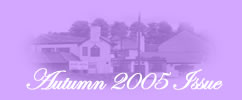Regulars
PC Health and Well-being
Ian Knowles continues his regular advice column with suggestions for Home Networking.
Many homes have more than one computer, as well as Internet capable games consoles.With the availability of
affordable broadband internet connections, either using the phone line or where installed, cable, it makes sense
to connect all the devices to the internet using a local area network (LAN).
The decision is do you use wire cabled or a wireless network? Wired networks require network interface cards (NIC) in each PC and a cable between two PC’s. If you have more than two PCs you will need a hub to connect them all.
Wireless networks require a wireless NIC in each PC and a wireless router; usually it is possible to have one PC connected via a cable (more if the router has a built in hub).
The advantages of using wired networks are; the network connections are faster (10/100/1000Mbps dependent upon the speed of the network cards installed in your PCs), always connected at full speed and they are secure.
The advantages of wireless networks are that they do not need any cable between each computer and you can use portable laptops etc, in any room in the house or even in the garden.
The disadvantages of wired networks are that cables need to be run between each computer, possibly requiring holes drilling or unsightly cables running round the rooms or under floors and carpets etc., and the connections are not easily moved.
The disadvantages of wireless networks are that walls and the distance from the transmitting device affect them and as such the signal strength and transmission rate (11/54/108Mbps) can fluctuate and loss of connection can be a problem.They are potentially unsecured and you must implement a security encryption protocol to prevent unauthorised access to your network, accidental or otherwise, by other nearby wireless network users.
Having said that, all potential problems can be overcome if adequate planning is undertaken.Wireless access points and repeaters can be used to extend wireless networks but as different makes of equipment may use slightly different or proprietary protocols, encryption and speeds of transmission, it is worth finding out whether they are compatible with each other, also the speed of any network is much faster than any currently available broadband service, which currently stands at 2Mbps in the Barrow area.
Next Issue:
What to ask Santa for this Christmas.
Webbie Wonders for autumn
Writing this in the blazing summer sunshine, it is hard to think about Autumn.To get me in the mood, my first selection is http://www.kidzone.ws/plants/index.htm - with great activities for children, information about why leaves change colour in autumn and photos of many leaves in their glory.
New England is famous for its Autumn show, so here at http://mstecker.com/pages/neautleaves_fp.htm are some of the most stunning shots that I could find. Further delving about here will reward you with infrared photographs, views of comets and a tour of many parts of the world.
For the more artistically minded, http://www.bbc.co.uk/paintingtheweather/csv/painting/leaves.shtml takes us to a stunning Millais painting ‘Autumn Leaves’ along with a short description / discussion of it. Linked to this theme, the painting of Autumn by David Teniers the Younger is also worth a look.
http://.oh-dear.org/archives/2005/05/22/autumn-leaves/ holds a poem describing the final journey of an autumn leaf in all its joy.
The remainder of this blog is hard going however and should be approached with care.
Finally, talking of blogs, http://brightfield.org.uk/autumnleaves/ is a place ‘for those in their golden years who maintain a diary or journal on the web’.There are a wide variety of entertaining and exasperating opinions and thoughts expressed and it just proves that anyone of any age can blog if they so want to.
Laura Hegarty
